So what is the onboarding email? It’s the first point of contact after purchasing or signing up for the product or service, so you’ll want to carefully craft these emails to ensure the customer remains with you for the long term and continues using your product.
I generally explain onboarding emails as an opportunity to lay the groundwork for expectations about process, communications, and next steps. In my business, I use onboarding email as an opportunity to reduce friction, manage expectations, and set the stage for a successful working relationship.
In this post, I’m sharing examples of effective onboarding emails from different brands plus some helpful templates so you can streamline onboarding and create a delightful customer experience.
Table of Contents
- Why Are Onboarding Emails Important?
- Benefits of Email Onboarding
- How to Write an Onboarding Email for Your Customers
- Onboarding Email Templates You Can Use Today
- 14 Email Onboarding Examples for Inspo
- Creating an Email Onboarding Sequence
- 8 Best Practices for the Perfect Email Onboarding Sequence
Why Are Onboarding Emails Important?
Converting visitors into customers is a long process, so you'll need engaging content and a well-executed sign-up form to get them to bite. Then, you can nurture subscribers until they convert.
That can be a lot of work, and I can confidently say that you don‘t want all that work to go to waste with a poor onboarding process. To keep first-time customers, you’ll have to provide more value.
You need to show that your business is worth their time and money, and in my opinion, you can achieve this by showing them they are worth your time. An effective email onboarding process can help you exceed their expectations and show them you care about keeping them engaged.
I’ve found that onboarding emails receive some of the highest levels of engagement from customers. GetResponse reports that welcome emails have an average open rate of 83.63%. While normal open rates vary by industry, it’s more than double most companies’ expectations for the average email.
The increased engagement presents a unique opportunity to open up communication channels and build trust right from the start.
Remember: Onboarding emails do more than create a positive first impression. They serve a higher purpose. Below are the benefits you'll enjoy by sending your customer a solid email onboarding letter.
There are a number of platforms out there that are great for setting up onboarding automations, and gathering data, but if you don’t know where to start, I recommend HubSpot’s Service Hub to assist with customer service and retention.
Benefits of Email Onboarding
Businesses are always working to convert leads into customers. Engaging email sequences can be one secret weapon to long-term success.
Not convinced? Here are two ways I’ve seen email onboarding provide value to businesses.
1. Email onboarding engages new subscribers.
Email is an extremely popular communication channel. Research shows that 4.73 billion people will use it by 2026 — more than half of the world's population. One study found that the average email open rate is 35.63%. Further, email marketing ROI currently stands at $36 for every $1 spent.
Email offers customers promotional content from their favorite brands, a way to reach out for support, and notifications that keep them up-to-date on product- and service-related news. I use email on a daily basis in my business and in my personal life, and can say with confidence that how brands email can have a massive impact on how I make decisions.
An onboarding sequence boosts email engagement and helps nurture relationships with your subscribers. Email can act as a noninvasive, proactive conversation starter, opening the door for valuable interactions that foster customer success like product and customer experience feedback.
2. Email onboarding increases lifetime customers.
If you want your business to succeed, you'll need loyal customers. These buyers minimize your churn rate. Plus, customer retention is less expensive than acquisition.
Greeting subscribers is one of the first steps to turning them into loyal customers. A well-designed onboarding sequence can make a great first impression on new customers. Kali Bennett, owner of The Waterworks Spa. Sauna. Swim. states, “We‘re always looking for ways to improve our onboarding. In addition to helping our new clients get to know our company, it’s an opportunity to make them feel extra special and help them understand what comes next.”
Failing to greet new customers gives the impression that you only wanted them to fill out your form. Your initial onboarding emails show you're dedicated to building a long-term relationship.
1. Write a catchy subject line and preview text.
If your email onboarding letter isn‘t eye-catching, you’ve already lost the battle.
The secret to increasing your open email rates lies in the subject line. A catchy, actionable subject line draws customers in. As someone who scans hundreds of emails a day in my inbox, I’m always drawn to compelling subject lines first.
Let's look at the screenshots below. Notice how the subject lines from Copy.ai, Adalo, and the Freelancers Union stand out?

Your subject line should provide enough information to pique the reader's interest. You can use the preview space to add a little more context, but be concise — space may be limited by device and email software.
2. Restate your value proposition.
I’m a big fan of clearly communicating your value proposition, and doing so in your onboarding email is no exception. Your value proposition tells the customer what you can do for them and how you stand out from your competition, so it’s important your onboarding emails reinforce this.
Remember — you’re in your business every day, but your customers aren’t. I always recommend using onboarding emails as an opportunity to continue building the relationship and the brand.

Once a customer establishes a relationship with you, emails should recommend ancillary services. This can help you solve their unique problems with complex solutions.
3. Show the next onboarding steps.
Now that you've reminded your customers why they signed up, help them start using your product or service. Usually, there are steps that users must take after signing up to get the most out of the platform. Some examples include:
- Completing their profile information.
- Setting preferences.
- Uploading necessary information (e.g., contacts into a CRM, profile picture for a social media profile, etc.).
- Upgrading their account or completing an order.
Here’s what Kimberly Navarro, marketing manager and senior copywriter at International Academy of Sleep, had to say about creating a ‘next-steps’ onboarding email.
“At IAOS, we offer learning programs for dentists pivoting to dental sleep medicine, and in their ‘next steps’ email we include where to find their lessons, how to create a log-in, and additional resources. This email makes it easy for them to know what to do after they join a program.”
4. Generate the “A-ha” moment.
Former Facebook head of growth Chamath Palihapitiya discovered the importance of initial engagement. If you can get a user to acquire seven friends in ten days, they are more likely to become active, returning users.
The goal is to get the user to an “aha” moment quickly to make your product memorable and useful, which ultimately helps your business grow.
Pro tip: To get started, identify your core values and the prerequisites customers need to receive this value. Then, you can use your onboarding email to guide new customers through these tasks.
5. Add helpful resources.
As I mentioned in the previous step, you want the user to see the value immediately. But customer success doesn't stop there. Depending on the complexity of your product, customers may need extra help.
For example, customers might need guidance on troubleshooting or using advanced features.
Likely, you‘ve already created helpful content addressing common questions from customers. Whether it’s tutorial videos, an FAQ page, or helpful blog posts, this content is essential to customer success.
Why not include it in your onboarding email?
You can then provide the tools they need upfront. They won't need to search for information after a problem arises. Namecheap does this with the email below.

6. Provide customer service contact information.
The next step to setting up your customers for success is ensuring they know how to contact you. You can‘t foresee every problem your customers might have. If they hit a roadblock, they’ll need a point of contact.
Adding this information to your welcome email builds trust and shows you care. This drives customer loyalty and reassures you'll be available if needed.
Avoid sending customers on a treasure hunt when they need to ask you simple questions. I’m a fan of KISS — keep it simple, sweetheart. When it’s easy to get support, your customers have a better experience.
7. Conclude with a call to action.
End your onboarding email with a call to action that entices customers to use the product.
Customers should be eager to start after you have demonstrated your company's value. Using a button makes the next action easy to spot.
You can see this in action with Trello.
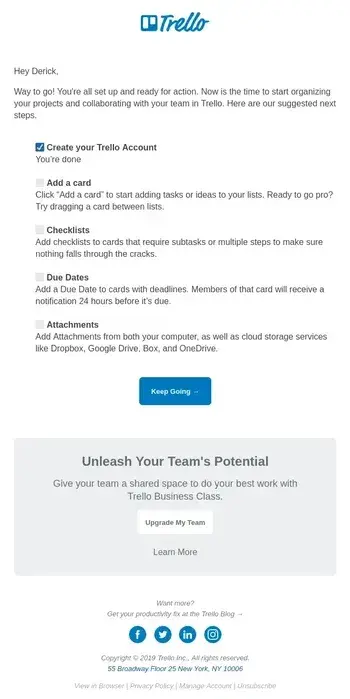
As your business grows, you‘ll want different email onboarding templates for many scenarios. You won’t have the time to write individual emails to each new customer. Take time to write a few thoughtful and intentional customer onboarding templates. You can then create a drip campaign or workflow.
Let's look at a few email onboarding examples that can be adapted to meet any specific business needs.
Onboarding Email Templates You Can Use Today
Every business will have unique elements in its onboarding emails. However, all onboarding messages should have the following components:
- A welcome note.
- An explanation of how your product or service will help the customer meet their needs.
- A heads-up of what to expect during the onboarding process.
Let's start by exploring a few starter onboarding email templates below. Or, if you’d like to dive right in, you can download 8 here.

Formal Onboarding Email Template
Welcome to [COMPANY NAME]
Hi [FIRST NAME],
Thanks for signing up for an account with [COMPANY NAME]. It's our mission to [COMPANY MISSION/PRODUCT VALUE PROPOSITION].
With your new [COMPANY NAME] account, you'll get:
- [TOOLS]
- [BENEFITS]
- [CUSTOMER SUPPORT]
If you haven't already done so, be sure to complete your profile and add your [CUSTOMER PREFERENCES] so we can send you content and resources that will help you get started.
We recommend new customers check out the following resources:
- [BLOG POST]
- [EBOOK]
- [VIDEO]
For customer support, don't hesitate to reach out to us via phone [NUMBER], email [ADDRESS], or live chat [CLICK-TO-CHAT].
Follow us on [SOCIAL LINKS] to get the latest updates!

Friendly Onboarding Email Template
Welcome, [FIRST NAME]
Hi [FIRST NAME],
Thanks for purchasing [COMPANY NAME]! We're happy to have you here!
We created [PRODUCT] to help people [COMPANY MISSION/PRODUCT VALUE PROPOSITION], and we‘re glad you’ve chosen us to help you meet your needs.
Over the next few weeks, we'll be sending you materials that will help you get started with [PRODUCT] to ensure you get the most out of it.
We‘ll also check in with you to see how your progress is going, and please don’t hesitate to reach out with any questions during this time!
We‘re so happy you’re part of this community!
Thanks,
[YOUR NAME]

Personable Onboarding Email Template
Getting Started with [PRODUCT]
Hi [FIRST NAME],
Thanks for signing up with us to use [PRODUCT]. My name is [YOUR NAME], and I‘m your point of contact for getting you up and running using the tool. I wanted to connect to see if you’d tried logging in and getting familiar with [TOOL] and if you had any questions.
New users typically find these resources helpful for getting going:
- [SETUP GUIDE]
- [HOW-TO VIDEOS]
- [COMPANY BLOG]
If you haven't already done so, be sure to complete your profile and add your [CUSTOMER PREFERENCES] so we can send you other content and resources that will help you get started.
Most customers find success by logging into [PRODUCT] and testing things out. If you'd like, we can schedule an onboarding call for next week using my meetings link, and I can walk you through it.
For customer support, don't hesitate to reach out to us via phone [NUMBER], email [ADDRESS], or live chat [CLICK-TO-CHAT], or you can connect with me directly using the contact information below.
I look forward to hearing from you soon!
Cheers,
[YOUR NAME]

Subscription-Upgrade Onboarding Email Template
If you operate a subscription-based company, you may have users upgraded from a free version of your product or service to a premium one. While these aren‘t necessarily "new" customers, they still require an email introducing them to their account’s new features.
Welcome to Premium!
Hi [FIRST NAME],
Thanks for your recent purchase, and congratulations on your account upgrade! We're excited to continue working with you, and we see this as the next step toward our goal of [COMPANY MISSION/PRODUCT VALUE PROPOSITION].
With your new [COMPANY NAME] account, you'll get:
- [TOOLS]
- [BENEFITS]
- [CUSTOMER SUPPORT]
We know you're probably familiar with our tools already, but we recommend new customers check out the following resources for the upgrade you just purchased.
- [BLOG POST]
- [EBOOK]
- [VIDEO]
As always, if you have any questions about your shiny new account, please don't hesitate to reach out to us via phone [NUMBER], email [ADDRESS], or live chat [CLICK-TO-CHAT], as our support team would be more than happy to help!
Cheers,
[YOUR NAME]

14 Email Onboarding Examples for Inspo
1. The Welcome Email
Customers who sign up for your product expect a welcome email. That's why this type of email has the highest open rate at 50%. A great welcome email strives to create a meaningful relationship rather than sell, which in my experience can lead to higher sales down the road.
Grammarly is a writing tool that helps users create error-free, written copy. It monitors grammar, spelling, tone, and various other customizable markers. Their welcome email lets new customers know what to expect from the service.
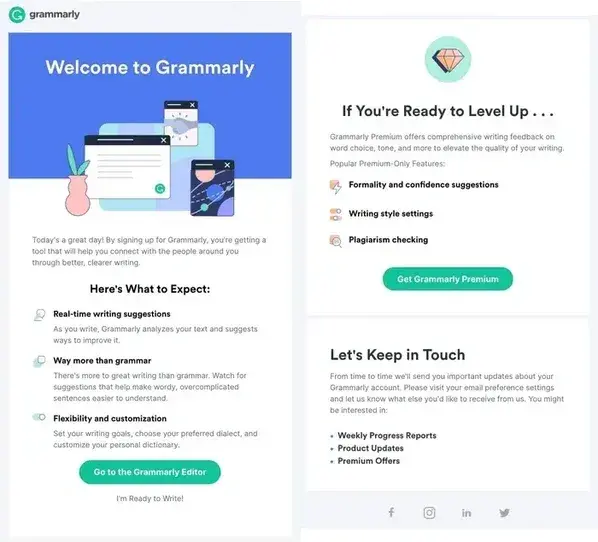
What I Love
- The email explains what users can expect from Grammarly‘s free and premium versions. Subscribers don’t have to go to the website to find this information.
- Subscribers learn what they'll get from the weekly emails. They can then decide whether to unsubscribe or not.
- Two powerful calls to action bring one to start using the product immediately.
Key takeaway: Customer loyalty starts with showing users what they'll get from a product immediately after they sign up. Making that visible to your customers translates to increased sales and happier customers.
2. Account Setup
Most customers today have a basic understanding of apps. They are confident and comfortable operating web products on their own. The account setup email promotes self-service onboarding.
The result is productive customers capable of resolving their own issues. This frees your team's valuable time for onboarding customers or doing product demos.
LastPass is an online security tool that helps store passwords and other essential data. Its onboarding email is straightforward, which reduces the likelihood of user error.
You learn what documents you can store in your personal vault, how to set up your account, and how to access the tool on all your devices.
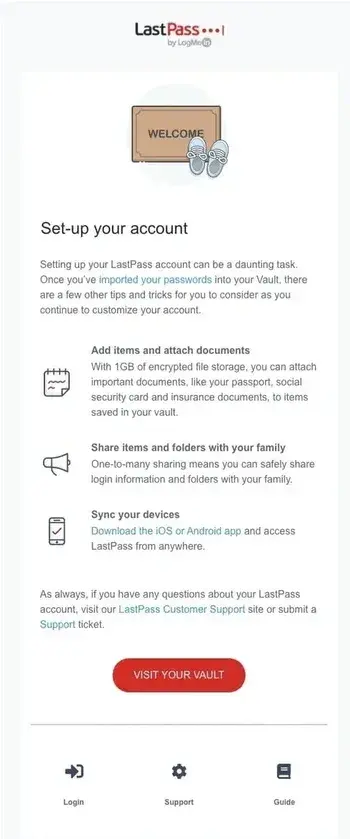
What I Love
- There's an easy three-step process for customizing an account. It gives the impression that the product is easy to use, increasing the chance of adoption.
- The message is short, concise, and specific about the details.
- There's a straightforward call to action below the fold.
- There's clear navigation in the footer.
Key takeaway: You can increase user adoption by encouraging quick and easy self-serve onboarding. A straightforward, three-step email shows that your product is easy to use.
3. Re-Engagement Email
Did you know 21% of your subscribers are likely to abandon your app after the first time using it. No business wants such high churn rates.
A re-engagement email sent to inactive users and cart abandoners is one of my go-to strategies for renewing brand interest and extending the customer lifecycle. Don’t worry if you see people unsubscribe. I know firsthand that it can feel like a blow, but it just means you’re passively cleaning your email marketing list.
Skillshare is an online teaching platform hosting thousands of courses for different learners. Learners can access it via their browser and even mobile app. Their re-engagement email below is a role model to follow.

What I Love
- Skillshare's headline is informal. The casual tone feels like communicating with a friend or family member.
- Icons illustrate the new features added to the product.
- There's an enticing discount.
- There's a clear option to unsubscribe. This is compliant with email-related laws and can help organize your mailing list.
Key takeaway: When creating a re-engagement email, focus on the benefits of your product. You may also offer a discount. This is a great way to attract customers seeking other solutions and turn cold prospects into hot leads. Lastly, never be afraid to ask subscribers to unsubscribe from your product.
4. Community Building
Consumers spend a lot of time on social media — I’m guilty of doomscrolling too. Good news! Building an online community is one way to capitalize on this habit. This is an excellent way to onboard new subscribers and build a solid base of product champions.
You can talk to your customers on a personal level to understand their needs better. Plus, customers can talk with each other to get support, explore new use cases, and share knowledge.
Check out how Adalo, a no-code app builder, invites new subscribers to its community and encourages user adoption in this email.
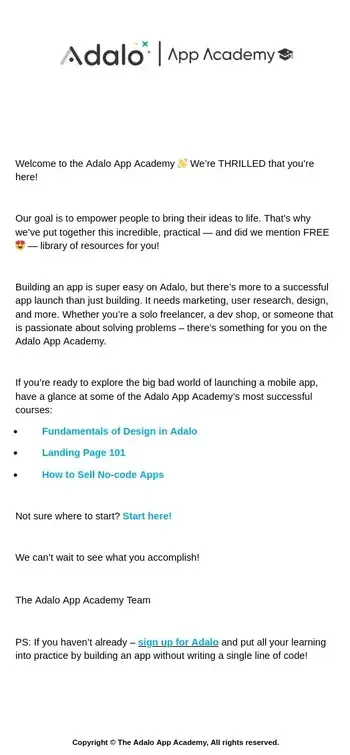
[alt[ onboarding email example from adalo app company
What I Love
- Plain text, bullets, and paragraphs of different sizes make the email easy to read.
- There‘s information on what you’ll get by joining the academy.
- There's a simple call to action below the fold.
Key takeaway: We all love communities and feeling like we’re part of something bigger. Offering new subscribers a digital gathering place makes them more likely to purchase your product. Plus, community creates a nice added value.
5. Offers
Another way to onboard customers is to entice them with an irresistible offer. It can be a bonus, free shipping, or giveaways.
Offers are one way to show appreciation and value to your customers. In my experience, these small gifts help build loyalty, offer a quick win or moment of delight, and also make repeat customers happy (and more likely to purchase).
Udacity, an online platform offering Nanodegree programs, does this in the email below. The company allows new subscribers and trial users to explore popular Nanodegree courses for 30 days.

[alt[ onboarding email example from udacity
What I Love
- An element of urgency is created with a short expiry date. This ensures more customers take up the offer.
- Two clear calls-to-action show what you get when you take a course from Udacity.
- It's personalized.
Key takeaway: Offers and incentives are a great way to entice customers to engage. You can encourage more adoption and help them see the value of the product. Remember to add an element of urgency to encourage quicker action.
6. Social Proof
Social proof is one of the best ways to nudge customers for conversion. I’ve found that people like what other people like.
Studies show 91% of consumers will trust a recommendation from someone they know. Your onboarding message should have social proof to reassure new buyers of your value.
Adobe is a creative cloud-based tool for marketing and document management. Here's an email with social proof from influencers that aims to attract more premium users.
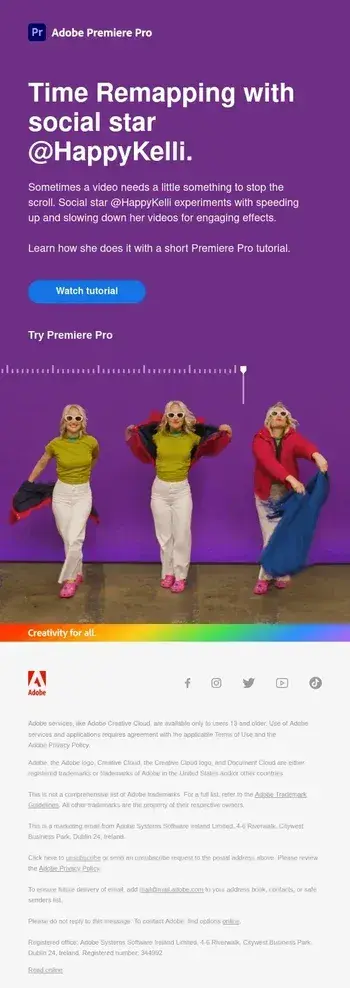
What I Love
- There's one paragraph with explicit instructions on what the tutorial is going to be.
- The email uses an influencer @HappyKelli as a guide.
- Bold headlines capture the reader's attention.
Key takeaway: Social proof is a great way to convince undecided customers. You can use case studies, customer testimonials, or reviews. Then, include social sharing buttons to turn subscribers into brand advocates.
7. How-To Emails
When launching a new product or feature, you must convince your customers of its value. A how-to email is one of the easiest ways to do so.
Offer a tutorial or step-by-step guide to show them the new offering‘s benefits. You’ll both deflate inquiries to your support team and establish yourself as an authority. I find these types of emails especially useful when it comes to products and services that require a little more high-tech know-how.
Airtable is a cloud-based platform for building powerful apps. Here's a how-to email it sends new subscribers to ensure smooth onboarding.
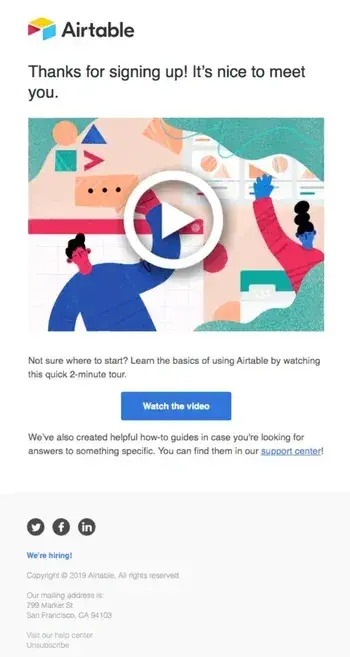
What I Love
- The email is easy to read.
- There's an option to watch the video in the inbox or browser.
- There's a link to their knowledge base where users can find specific information.
Key takeaway: Make use of videos to connect with your subscribers without leaving the inbox. Don’t be afraid to use media other than text. 83% of people prefer watching video for instructional content rather than text or even audio.
8. Competitor Comparison
Even after purchasing, customers may have lingering buyer's remorse. They may not trust your product or see its value, which is something I’ve encountered a few times, but I have a fix for that.
A great way to keep them satisfied and squash any regret is to show them why you're the right brand. You can do this by comparing your product with others or explaining why they made the right choice.
Here is an email onboarding letter from Horween Leather, a leather tannery. The message emphasizes that customers made the right choice.

What I Love
- There are bold, large text and images.
- The message explains why Horween Leather is better than its competitors.
- A combination of text, images, and navigation above the fold make it look like a website, promoting easy interaction.
Key takeaway: Competitor comparisons can be a great way to convince on-the-fence customers of your benefits. When doing so, show customers a library of your product to encourage more purchases.
9. Product Update
Product update emails are part of re-engagement marketing strategy. These announcements with new features are meant to capture your audience's attention to take an exclusive look at your product and if possible, try out the new features.
These emails show customers you are listening to their feedback and explain how the new feature works. In my business, I’ve made a few changes to my services after receiving feedback from my customers, and I always made sure to let them know, resulting in increased trust and excitement in my brand.
Here is an excellent example from Ryte, an SEO tool that helps you monitor, analyze, and optimize your website's pages and keywords to increase search traffic and conversion rates.

What I Love
- The message highlights important features that come with this new update. Customers don't have to call support or visit the site to learn about them since everything is in their inbox.
- There's great use of emojis and visuals.
- The sign-off shows where this email comes from, making it more credible.
Key takeaway: Product updates are a great way to push customers to finish registration or upgrade.
10. Invitation Emails
Launching a new product or feature is inspiring. You always want to see how users react to the product.
The best way is to give your users early access by inviting them to try it out. These emails create anticipation, as everybody wants to be the first in line. When I participate in beta launches, it always feels like I’m getting an exclusive or even VIP experience, which is something you should want your customers to feel.
Let's see how Aero, an air travel company, does this with the email below.
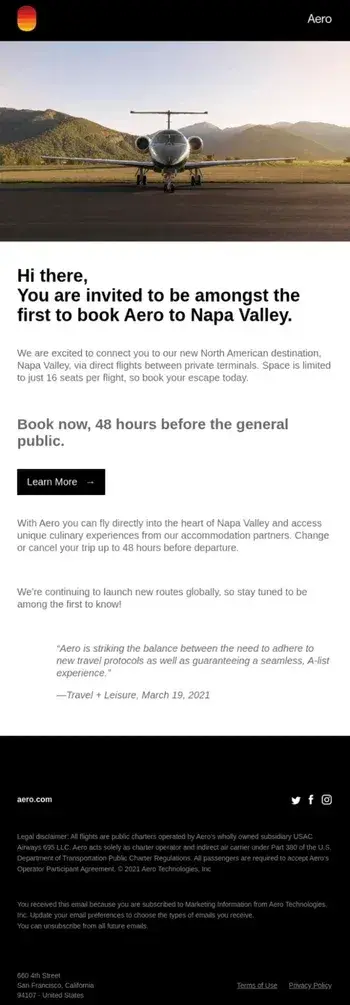
What I Love
- There are short texts and paragraphs.
- There's a bold heading with a prominent call to action for new subscribers to book before time elapses.
- Scarcity encourages quick sign-ups.
Key takeaway: Giving your customer first-time access to your product/service shows care. It also makes them more curious and willing to continue using your product. Use invitation emails to better understand your audience.
11. Thank You Emails
Sometimes your customers simply want to be acknowledged and appreciated. Thank you emails allow you to show appreciation and increase the value of new subscribers by guiding them on what to do next. And, speaking from experience, it makes your customer feel happy, which is always a win.
reMarkable is the first company to make a real digital paper tablet. Plus, they know how to write a thank you email.

What I Love
- What attracted me to this email is the conversational language and storytelling, making the email joyful.
- A combination of text and images makes it visually striking.
- The font used to sign off makes the email look really handwritten.
- The image of people makes the email authentic.
Key takeaway: Sending a thank you email gives customers a sense of satisfaction and gratitude. It allows readers to connect with your brand. This offers an opportunity to increase loyalty and engagement with your product.
12. Rewards
In a competitive market, attracting customers and even building loyalty can be daunting. One trick you can use is to give discounts as a reward. After all, who doesn’t love a little reward popping into their inbox every now and then? I certainly do!
Online investing app Stash has helped millions of Americans invest in their future. Let's see how it encourages more user adoption with this email.

What I Love
- Perks are clearly defined.
- Great call to action positioned above the fold, promoting easy engagement.
- Instruction on how to claim the offer.
Key takeaway: Giving rewards is a great motivational factor. With the motivational seed planted, the buying process becomes easy for customers.
13. Demo
Not every customer that signs up for your product knows how to use it. In fact, 55% of customers have returned a product because they lacked this knowledge. I’ll be the first to admit I don’t have 100% knowledge of all the products I have in my tech stack, and I lean on demos when I need to do something that’s not intuitive.
Demo emails are a great opportunity to show your product features in action. This also helps reduce call center volume.
June Oven is a home automation company that produces intelligent ovens. This demo email employs a conventional way to educate customers on using the product.

What I Love
- Bold headlines quickly capture attention.
- The layout is simple. There's a large image above the fold, a paragraph or two about the email, and then an inviting call to action.
Key takeaway: Use demos to connect with your audience and understand them better. Showing customers how to use your product decreases friction in the onboarding process.
14. Customer Support Email
As a brand, you know most problems customers will face when they subscribe to your product. So once a customer has signed up, you can send them an email about how they can solve certain bottlenecks to make onboarding frictionless.
Providing proactive customer support improves customer experience. A great customer experience will encourage customer loyalty, boost sales, and lead to referrals.
I love this example from Zapier, a tool you can use to connect your apps and service to automate workflows.
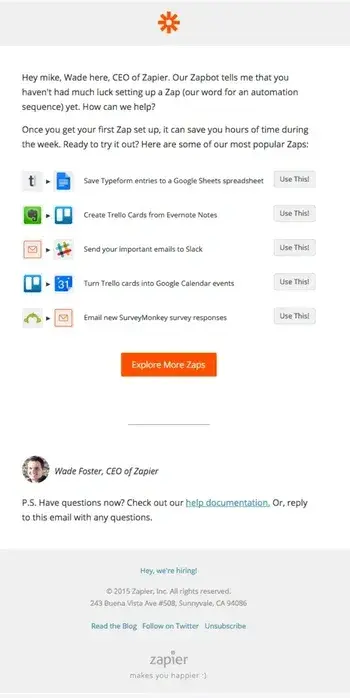
What I Love
- The combination of text and images makes it visually interesting.
- It is personalized with an issue the customer may be experiencing.
- It comes from the CEO — a surprise that helps increase trust and credibility in your product.
Key takeaway: As a business, you should anticipate problems that your customers will face when they sign up. Showing customers how to get started with your product or reach you when they encounter a problem helps reduce churn.
Now that you have a few templates and examples, let's dive into some best practices that you can use to create a full email onboarding sequence.
Creating an Email Onboarding Sequence
Creating an email onboarding sequence isn't difficult. Making it successful is the real challenge.
If you're creating an onboarding sequence for the first time, there are some fundamental steps you can take to ensure success.
I recommend starting by personalizing your messages. A warm welcome email addressed directly to your audience is a great way to kick off the onboarding experience.
You should also have a way to monitor inactive users and come up with ways to re-engage. Don't forget to optimize your emails for mobile, too. 60% of campaign emails are read on a mobile phone
If you find that customers aren‘t engaging as much as you had hoped, don’t fret. All you need to do is continue testing your emails.
A/B test new designs, write different copy, and reconsider the timing of your emails as well. This helps create an unforgettable email onboarding experience.
If you're looking for a few more tips, read on to the next section where I outline how to design the perfect email onboarding sequence.
8 Best Practices for the Perfect Email Onboarding Sequence

1. Start with a confirmation email.
Start by checking that your subscribers are real people with legitimate email addresses. I’ve had experience with fake subscribers before, and it was a hassle to remove them, so you’ll want to be proactive in screening. The easiest way to find out is to send a short confirmation message to validate the new subscriber's email — or a double opt-in.
This is a fundamental process that the majority of your subscribers will complete immediately. However, there are always some who will miss or forget the email entirely.
To make sure they complete confirmation, you should send a follow-up email.
Confirmation emails don't need to be fancy, but they do need to have a clear call to action.
Here's a real-life example from HubSpot:
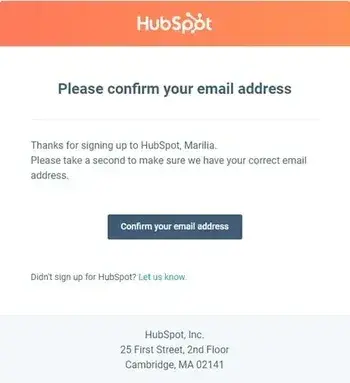
HubSpot also adds a touch of personalization to greet its new subscribers. Then, the message gives a clear explanation of what the new user needs to do next.
2. Send an impressive welcome email.
Now that your subscribers have confirmed their email, it's time to set the onboarding gears in motion.
The welcome email is, undoubtedly, the most important part of your sequence as it will set the tone for your onboarding process. This email is always a part of my onboarding sequences. It should be a powerful impression trigger that convinces new subscribers to open the rest of your emails.
Make your customer feel like you’re rolling out the red carpet and genuinely thrilled to have them as a new customer.
Failure to create a strong impression trigger will result in low open and click-through rates. If you want to create a process that turns subscribers into customers, your company needs to create a high-value welcome message.
Here's an example from Webflow you can imitate.
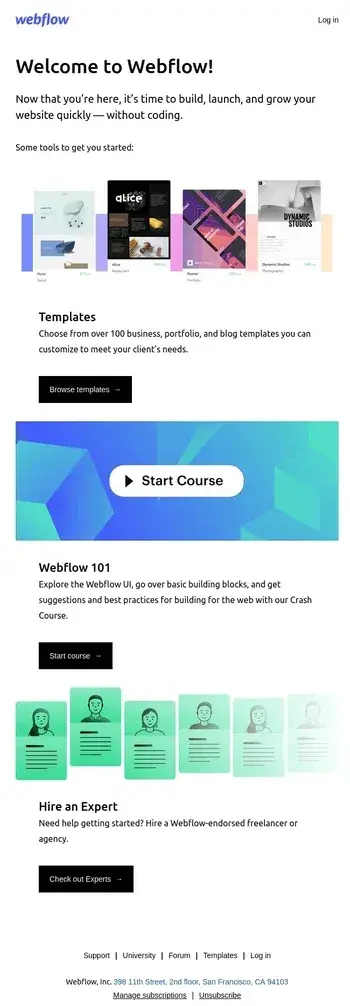
Segment your audience based on the actions they take. Then, target them with different emails. For inactive subscribers, highlight your value proposition and offer further information about your services.
3. Create different sequences for engaged and disengaged users.
One challenge you may encounter is having subscribers with different levels of engagement.
Some will rush to your content, others will sign up, but remain inactive. To account for this, you'll need different sequences for active and inactive users.

Segment your audience based on the actions they take and target them with different emails. I have a wide range of sequences so no one falls through the gaps or (hopefully) receives communication that may not be relevant to them.
For inactive subscribers, you should highlight your value proposition in a way that attracts their attention and offers further information and assistance for re-engagement.
4. Leverage personalization.
When it comes to email engagement, personalization can drive higher open and click-through rate.
But there‘s a catch. To personalize content, you need data about subscribers. The more data you have, the easier it’ll be to customize experiences.
Consider leveraging both simple and advanced personalization techniques. For example, your onboarding sequence should address customers by their names. I’ve found that most email marketing platforms make it super easy to add a personalization token to your email. If yours doesn’t, it might be time to explore your options!
You can also send your emails from an employee or company email rather than a generic address.
An awesome example of personalization comes from Bonjoro, a company that personalizes its onboarding sequence with a unique video message.
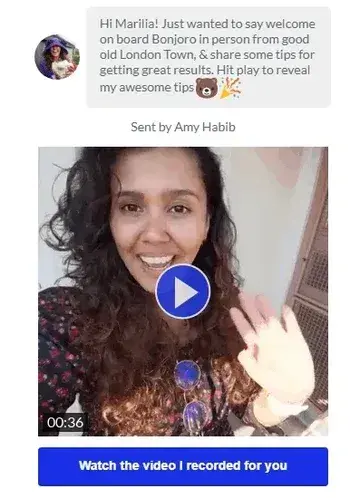
5. Optimize emails for mobile-first users.
With the popularity of mobile devices, more people use tablets and phones to check messages and interact with companies. I regularly check my email on my phone, even if I’ve checked it on my desktop only moments before. Don’t forget that 60% of campaign emails are read on a mobile phone. Neglecting mobile devices will result in low engagement.
Mobile-optimized campaigns aren't rocket science. But, you need to keep in mind some of the most important mobile-optimization practices.
First, you need a responsive email template that makes your emails look good on all devices. Then, you need to pay attention to your visuals and copy. Use simple images that load quickly.
Then, take note of your subject line. Mobile devices will display a limited number of characters.
For instance, Zapier has a simple and responsive email template that shows mobile users information about the app.
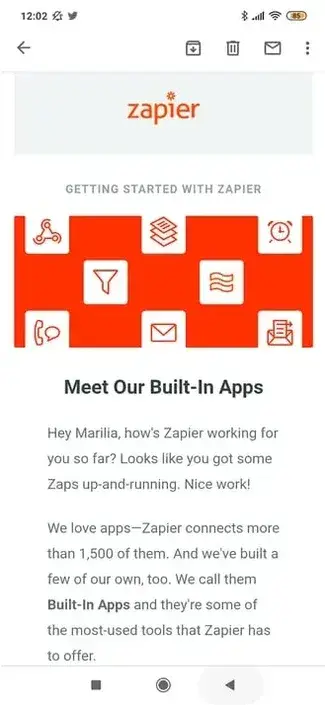
6. Center content around your call to action.
Setting goals for each email onboarding letter will help you achieve greater click-through rates. However, without the right call to action (CTAs), your new subscribers will simply read your emails without navigating to your offers.
CTAs capture your subscribers' attention and incentivize them to take action. To create the perfect CTA, you need to use the right copy and visuals to boost its performance.
Highlight your offer's benefits to give your subscribers a taste of what they can gain with their purchase. At the same time, an image will make the message easier to digest and lead them one step closer to clicking on your content. I like using a balanced mix of text and graphic CTAs to make sure my message makes its way to my customer in the way that they best receive information.

This example from Airtable shows how copy and a CTA can work together. Also, the company allows its subscribers to contact them directly.
7. Test your messages.
Testing your messages allows you to deliver more engaging content. Start with A/B testing (a common test that determines which elements lead to higher opens and clicks).
To run an A/B test, you need to create a variation of your initial design (also known as a “control”). Then, send both versions to small groups of subscribers.
I typically conduct my A/B tests with the subject lines since getting the customer to open the email is the first step.
For an effective test, you should create many variations and send them to different segments. When you collect enough data, you can conduct a behavior analysis to optimize your copy, visuals, and CTAs to boost engagement.
8. Show subscribers how to use your product or service.
First-time users have no experience with your products or services. They'll need extra help getting started. Doing so will boost their confidence and help them troubleshoot problems on their own. In my experience, some of the best tools and platforms out there may not always be the most user-friendly, but they tend to have an extensive catalog of tutorials.
Businesses like WebStarts use their onboarding sequences to deliver short lessons. This helps new users get familiar with the platform and the basics of website building.

Create the Perfect Email Onboarding Letter
My main takeaway is this: Your onboarding email should aim to set customers up for success. You'll have to try different tactics to see what works best, but now that I’ve given you several templates to start with, some examples to reference, and some best practices, you’re on the right path.
Crafting good onboarding emails is all about reducing the friction that comes with becoming a new customer, and when your customer has a smooth experience with onboarding, they’ll be more likely to become a repeat customer.
The work doesn’t just stop with the emails getting delivered; be sure to monitor customer success metrics to see how your emails are performing, and constantly iterate on your sequence so it suits your customers.
Editor's note: This post was originally published in April 2020 and has been updated for comprehensiveness.
Customer Onboarding


.png)

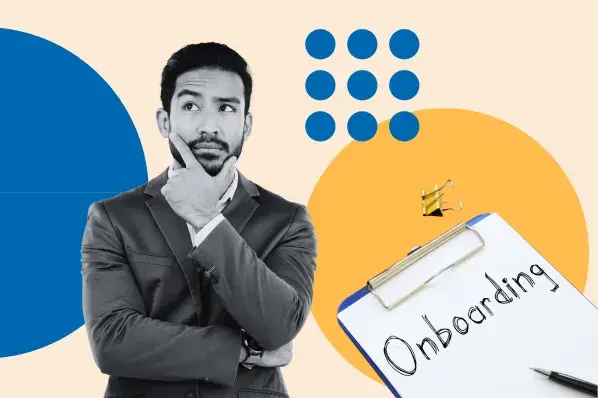
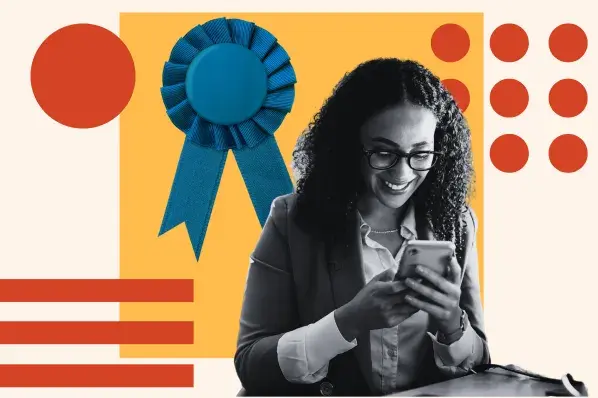

![10 Customer Onboarding Challenges You Might Face This Year [+Expert Tips]](https://53.fs1.hubspotusercontent-na1.net/hubfs/53/ai%20customer%20service%20predictions%20(2).webp)
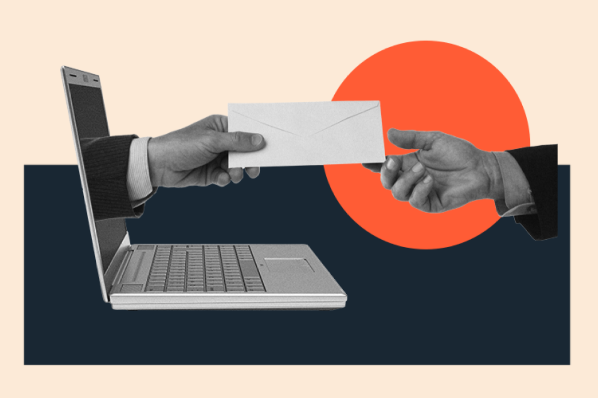
![Digital Onboarding: How to Make It Work For You [+ 5 Helpful Tools]](https://53.fs1.hubspotusercontent-na1.net/hubfs/53/digital%20onboarding_featured%20image.jpg)
![Perfect your customer onboarding with our expert tips [+ checklist]](https://53.fs1.hubspotusercontent-na1.net/hubfs/53/client-onboarding-best-practices-1-20251029-7553263.webp)
.webp)
